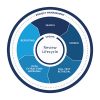Although medical device companies continue to be careful with their budgets, they are still on watch and are making room for strategic acquisitions that will bring a big boost to their portfolios. In a brief interview with MedTech Intelligence, Karl Freimuth, partner and co-head of the U.S. industrials practice at Livingstone, an independent M&A and advisory firm, expands on his latest report, “2018 Year in Review & 2019 Outlook” and what he sees as key industry drivers, challenges and opportunities.
Industry Challenges
- Skilled labor shortage—this is pervasive more broadly in the U.S. manufacturing industry
- Current low unemployment rates
- Both of the above factors are causing businesses to struggle to find the right people to keep up with the demand from OEMs
- On a positive note, these challenges are prompting contract manufacturers to invest in capital and technology to increase efficiencies in workflow and production. “I think part of the labor shortage is actually driving production innovations on the plant floor,” said Freimuth.

Areas of Growth
- Robotic surgery and minimally invasive surgery is strong. The robotic surgery market is experiencing “explosive” growth in the 20+% annual range. “J&J just announced its investment in Auris [Health], which is another surgical robotic platform that was started by the former founder of Intuitive Surgical [Frederic Moll, M.D.], which is the largest robotic surgery platform globally,” said Freimuth. “That market continues to grow at a rapid pace. At med schools, surgeons are being taught on robotic surgical platforms. Data indicates that patient outcomes, safety and recovery times are being reduced; it’s more cost efficient for the hospital systems. I think that is a high growth trend within the surgical treatment of patients.”
- Artificial heart segment: Ventricular assist devices are helping patients live longer without requiring a heart transplant. The market continues to see a demand with the pervasive nature of heart disease in the aging demographic. This cardiovascular technology segment is experiencing high single-digit to mid-teens annual growth.
- Other growth areas include POC testing, stents, clot retrieval devices, diabetes management technology, orthopedic implants, devices that treat atrial fibrillation, TAVR, spinal cord therapeutic technology and remote monitoring
Deals & Acquisitions
- OEMs are making significant investments in internal R&D and are deploying capital to make acquisitions
- OEMs and contract manufacturers are engaging in M&A activity. “There is a continued pent-up demand for acquisition activity at the tail end of this eight- or nine-year bull run we’re fielding. There are assets coming to market in 2019 ahead of the 2020 presidential cycle, and with major acquirers performing well and continuing to grow, they’re seeking acquisitions to continue building their platforms,” says Freimuth.
- Industry consolidation on the part of OEMs and contract manufacturers has changed the landscape. “If small- to mid-market business owners (device manufacturers or outsourced contract manufacturing partners) aren’t investing in engineering talent, additional capital equipment, and facility expansions to keep pace with the growth of the industry, they run the risk of having their businesses tail off and lose their position on platforms as they sunset. There is clear momentum in the industry for a continued strong year in terms of middle market exits both at the contract manufacturing level as well as the OEM level.”
- Medical device OEMs prefer to acquire proven technologies to fill portfolio gaps and “plug-and-play” into their global sales and marketing infrastructure.
- Some OEMs continue to be skittish towards investing in nascent, high-risk technology that isn’t FDA approved







